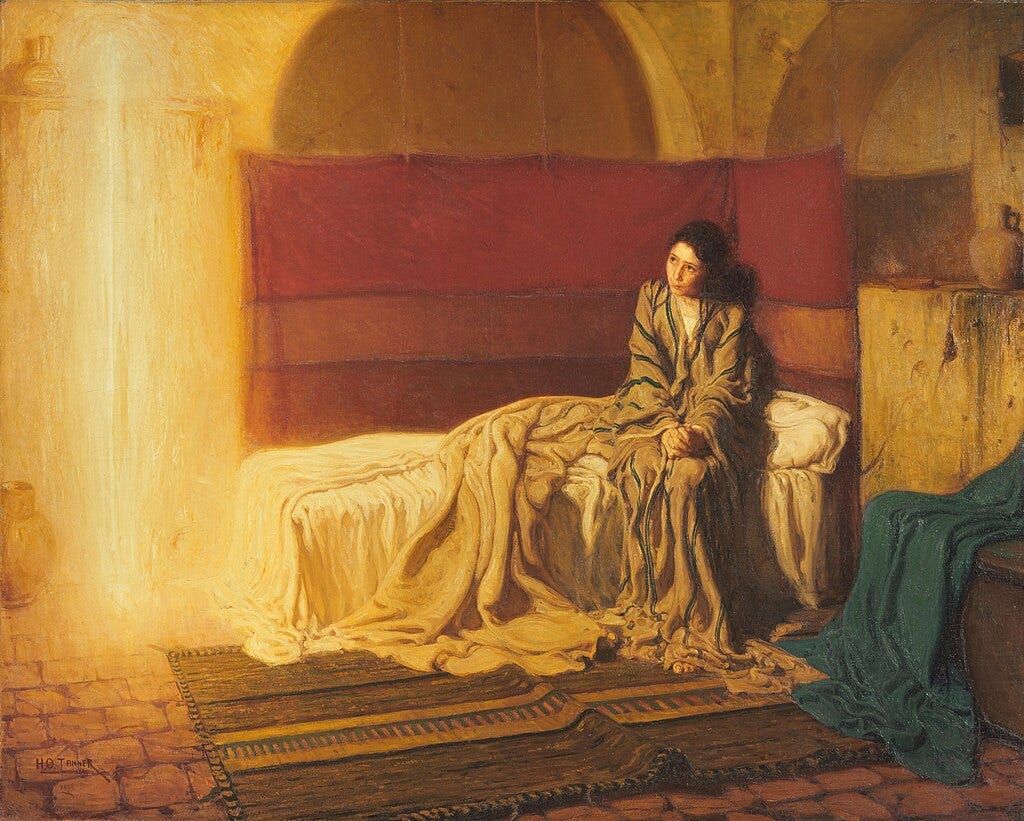A tent peg for Sisera, A millstone for Abimelech, A blade for Holofernes, A gallows for Haman, And an Eternal sword Forged in a Virgin furnace For Death. “Striking it with the hammer, drove it through his brain” “Dashed it against the head of Abimelech” “Strengthen me, O Lord God, at this hour” “I have not eaten at Haman's table” “Be it done to me according to thy word” Resurrexit, Sicut Dixit. Aleluia!
After the Fall in Genesis 3, God gives a promise to Eve that theologians call the Protoevangelium, the first-gospel: that the serpent's head would be crushed by the Seed of the woman. This promise is ultimately fulfilled in Christ. In Jerome’s fourth-century translation of the Bible, called the Vulgate, it was written that “she would crush his head,” where the Hebrew likely says, he. While this was likely a scribal error, it is not necessarily an incorrect idea, because, in a sense, Mary the mother of our Lord did tread on the serpent’s head by bearing the Headcrusher for us.
This week I was considering the typology of the protoeveangelium, inspiring the short poem that opened this post. As with many of the promises of God, the fulfillment of this first-gospel promise is rich and multi-layered. At one level, we have the types of Christ: David, for example, who crushes the head of Goliath. But we can also trace another thread throughout salvation history connected to this promise.

In the book of Judges, we read of how God crushes the head of the wicked king Sisera by the hand of Jael, the wife of Heber. She drives a tent peg: a nail, through his skull. Then Deborah sings a song:
Most blessed of women be Jael,
the wife of Heber the Kenite,
of tent-dwelling women most blessed…
…she struck Sisera;
she crushed his head (Judges 5:24-27)
The symbolism here is rich. Jael is called blessed, with similar wording to Mary’s song in Luke, that all generations will call me blessed (Luke 1:48). Jael brings destruction to the enemy of God and deliverance for his people with a nail, which prefigures the crucifixion. She is what the Apostle Paul would call a keeper-at-home (Titus 2:5), and God uses her in her domestic duties to topple the king of an army.
Later, God crushes the head of Abimelech, the evil son of Gideon, by the millstone thrown by an old woman in Israel.
And a certain woman threw an upper millstone on Abimelech’s head and crushed his skull. (Judges 9:53)
Abimelech’s skull is broken, but he lives on long enough to ask the man next to him to strike him dead, so that it could not be shamefully said, “a woman killed him”. This can be compared to the way that the principalities and powers were put to open shame in the cross of Christ: the strong were destroyed by what is lowly and despised. An old woman, unimportant in the world’s eyes, unexpectedly ruined the usurping plans of Abimelek; a young maiden, unpopular and poor, unexpectedly ruins the plans of the cosmic usurper, the devil. She bears the One who plunders the strong man’s goods.
While Israel was in Exile, God put an end to the life of the evil man Haman by the courage of Esther. By her quiet beauty and courage, Haman is destroyed on the very wooden pole that he designed for the destruction of the righteous. She surrendered herself to the will of God, confessing that she was born for such a time, echoing the Marian confession, fiat mihi secundum verbum tuum, “let it be done to me according to your word” (Luke 1:38).
As Eve received a promise of the serpent’s destruction through her descendent, now a virgin named Mary is told good tidings. The protoeveangelium, finds the beginning of its fulfillment in the Annunciation. That which Eve dreamt of is experienced by Mary. The Seed of the woman is finally here. And he will be called Son of God (Luke 1:32).
Our God put an end to the serpent’s lofty boasts, not with armies carrying banners, But His banner over me is love (Song of Solomon 2:4) There shall come forth a shoot from the stump of Jesse (Isaiah 11:1) and that branch has Flowered before it bore its Fruit.
He walks from the garden of Gethsemane, sweating great drops of blood from the temptations there. Where our first parents fell, the Second Adam emerges sinless. The double-tongued crowd shouts, “Crucify Him!” He walks the winding, serpentine path, carrying His cross.
And Mary stood before her crucified Son and Lord atop the hill called Golgotha: the Place of the Skull.
His heel was bruised, and a sword pierced her heart also (Luke 2:35).
And as Christ is stretched out on that tree, gasping for air, He pushes up off of His pierced feet to get a few words out. The Eternal Word Himself speaks His last:
“It is finished.”
Our God has crushed the serpent’s head.





@George Bothamley , the paintings in my latest are some of my favorites, especially the one by William-Adolphe_Bouguereau.
Thought you may appreciate, also @Ruth Gaskovski and other painting enjoyers
@Nathan Woods , and @jzschafer would love your feedback on the poem I wrote that opens this post.